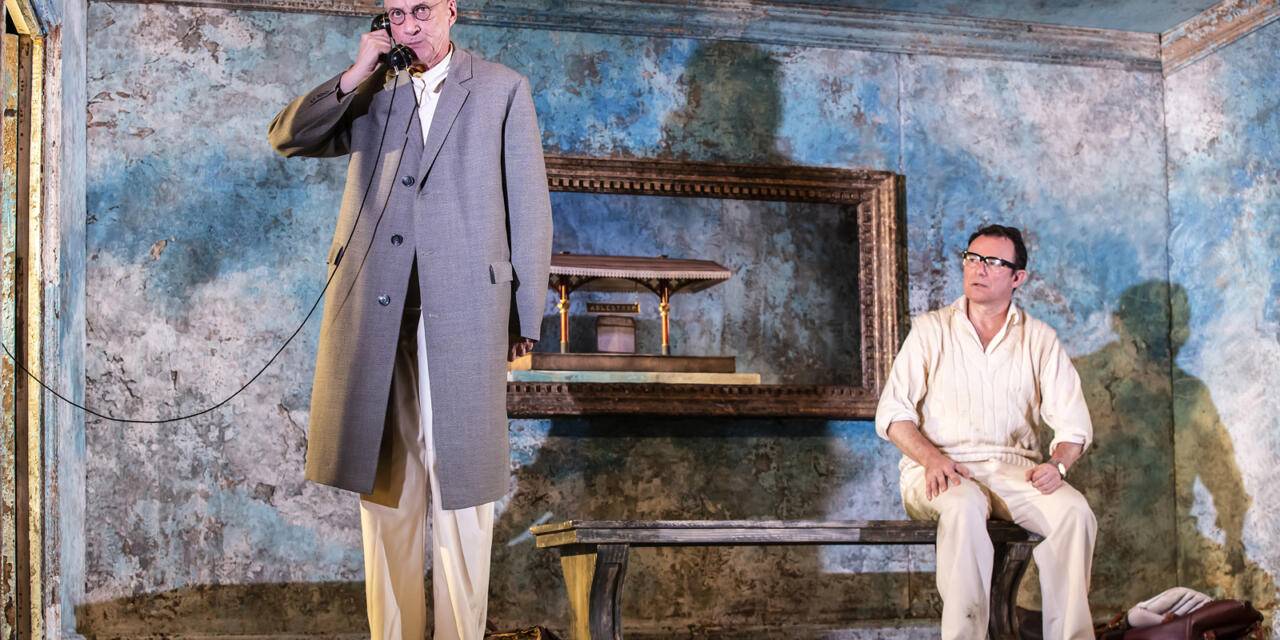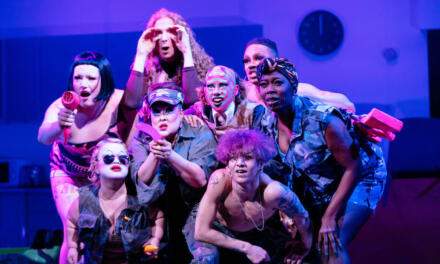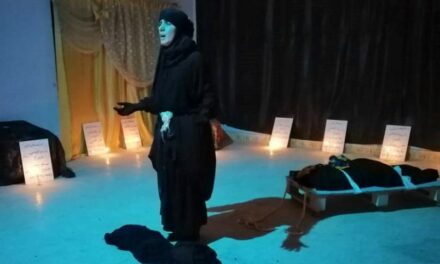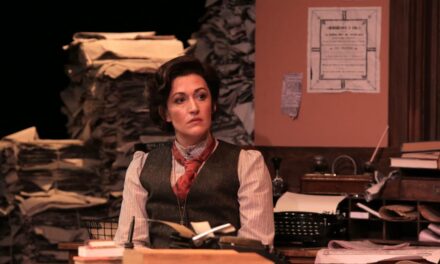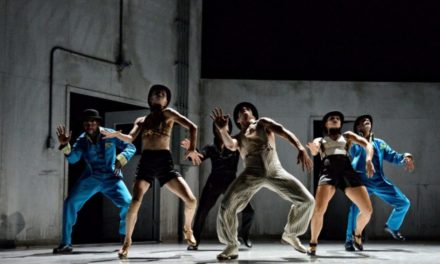Originally Shomit Dutta’s new play Stumped was screened online from 27 September 2022. Streaming on-demand Original Theatre Online created a new hybridized form of online theatre that merged the live and online realms to create a production that challenged our expectations and notions of how we exist in the Digital World (see the companion piece that reviews the online version). Since May 2023 Stumped has simultaneously become available streamed online on-demand and performed live in theatres across the UK and Ireland.
As Original Theatre Online created a new hybridized category of online theatre through blending the live and online, so their new live theatre production of Stumped equally defies and hybridizes genera categorizations by hovering around the borders of: black comedy, farce, mystery, thriller, a ghost story, Harold Pinter’s ‘comedy of menace’ in which the characters are humorously but horrifically menaced by mysterious outsiders, or Samuel Beckett’s staging of the existential absurdity of the human condition, blending elements of commedia dell’arte, Theatre of the Absurd, surreal and Brechtian theatre.
The main premise of Stumped stays the same in both mediums. We find the two cricket-obsessed Nobel prize winners Samuel Beckett (Stephen Tompkinson) and Harold Pinter (Andrew Lancel) as waiting batsmen in a darkly comic spin on Beckett’s Waiting for Godot and Pinter’s The Dumb Waiter. Act 1 is set on the balcony of a cricket pavilion and Act 2 finds them on the village green drunkenly waiting for a lift from a stranger called ‘Doggo’ who may never come. With the live theatrical version Dutta has added a new 20-minute act to the end of Stumped. The 2023 live theatrical version has an additional Act 3 that finds Beckett and Pinter continuing to wait at a railway station in a scenario that recalls the black comedy and tragedy of Maddy’s journey and waiting at another train station in Beckett’s radio play All That Fall.
With the online on-demand version of Stumped the medium allowed Original Theatre Online to explore the digital screen as prior boundary challenging, through utilizing the dual methodology of displaying other three-dimensional viewpoints of the moving image working in concert with an emphasis on the presence of the live online. This live online spatiotechological exploration of the digital screen created a landscape for the viewer experience somewhere in-between the live and online. A border zone in which Stumped online could explore the digital screen as a porous membrane. Insisting on the presence of the live online enabled Original Theatre Online to dissolve any boundaries between the object and subject, real and unreal illusionary realms to produce a new experience of the digital screen. A new screen experience that prevents immersion into the screen reality seen. A viewer experience in opposition to the contemporary drive to immerse the viewer deeper and further into the alternative screen reality by producing ever higher definition images and thus seemingly ever closer proximity to the screen reality presented.
Original Theatre Online created an ontologically unstable world that oscillated an in-screen viewer in-between the real and unreal, live and online digital experience. Oscillating in-between the actual and virtual realms placed the in-screen viewer in an unstable existential void that contained no, or an infinite number of undefined possibilities in spatial and temporal contexts. A no-man’s-land and existential void in which the only stable reality and meaning that exists is the one that the in-screen viewer constructs for themselves or is constructed for them out of the endless possibilities available from the imagination.
In their insistence on the presence of the live online Original Theatre Online created a new experience of the digital screen that produced the same Brechtian alienation effect used on-stage within live theatre. Stumped online created an audience that does not immerse themselves into the action or identify with the characters, but remains sufficiently outside of what is happening on the stage (or screen) to judge it critically. By foregrounding the presence of the real and live online, Original Theatre Online made the liminality of the digital screen visible, consequently revealing the suspended a priori conditions of space, time and causality within the screen. As a consequence of this revelation the knowledge that this liminal zone is the geopolitical battleground of the real and virtual worlds for the ontological stability and hence presence and attention of the online viewer was produced and made visible.
Through re-directing the attention and sense of presence and immediacy of the online viewer to their own fluid, indeterminate and suspended a priori conditions in the liminal context of the digital screen, Original Theatre Online prevented immersion into that screen world, consequently producing a metatheatrical hyper-reflexivity on the processes of creating the reality that they exist in. A locus of process that speaks of Gilles Deleuze’s ‘duration’ (durée). A place in which consciousness is a flow of experience and durée is the immediate awareness of this flow. A consciousness of the continuous movement and flow of experience that produces an intense experience of presence and immediacy for the viewer, due to the individual participatory act of having to continuously create the world that they inhabit. A world of active engagement and participation rather than passive viewing. This knowledge and engagement in the processes of creation distances, neutralizes and reforms the digital screen from an existential no-man’s-land into an ontological playground for the online viewer. A playground that opens-up the discursive possibilities on the geopolitical nature of the digital screen; who, or what constructs the worlds that we inhabit?
Continuing to invite the maker and viewer into questioning and exploring the nature and construction of reality and notions of the live, Original Theatre Company now bring Stumped into the medium of live theatre through their 2023 UK and Ireland tour. A live production that continues to demonstrate the porous boundaries between the real and illusionary realms. Consequently, sustaining the possibilities of opening-up the conversations surrounding the questions concerning who or what constructs the realities that we exist in.
Dutta’s script of the live Stumped stays essentially the same – apart from the addition of Act 3 – as the online version, thus producing the same liminal zone and ontological instability that characterizes the piece. Consequently, the live version of the script uses the same stage devices as the online play, such as; having the actors resemble Beckett and Pinter to a remarkable degree, having them bounce between significant events in the writer’s own lives and the lives of their characters, using real biographical details, lines from their plays Waiting for Godot, Krapp’s Last Tape or The Dumb Waiter, using the surreal backcloth reminiscent of the pompier trompe l’oeil of Beckett’s play Happy Days, the same writing style of their work and the spatiotechnological staging (see the companion piece that reviews the online version).
Again, the spatiotechnological staging of the live version visibly stretches theatrical conventions, enabling Original Theatre Company to create the same consciousness of the process and flow of performance as the online version of the play. The live play opens – as with the online version – on a huge proscenium arch constructed as a dark, old gold, heavy wooden picture frame literally constructing and framing the box set. Opening Stumped with this literal picture framing of a play at the very moment the audience are in the process of suspending their disbelief – shrugging-off one reality while preparing to immerse themselves into another – immediately breaks and prevents the theatrical convention and process of suspending disbelief. The literal picture framing of the representation of the real freezes the live audience in a moment in-between the suspension of disbelief and its cancellation; in-between the illusion and reality. Consequently, this framing not only breaks the fourth wall, which subsequently blurs the boundaries between realities and creates a liminal landscape with fluid and indeterminate conditions of space, time and causality. It also creates a fourth wall – which is essentially a division between realms – that has the ability to expand its borders to become a permeable and elastic membrane able to stretch and capture and contain an auditorium and its audience in its embrace. The live on-stage action takes place in the fourth wall.
As the digital screen itself expanded to become the liminal landscape in which the action of the online play took place, so the fourth wall of the live play becomes a permeable and elastic membrane able to merge the realms of reality and illusion through the action of the play. The live production exists inside an expanded and all-encompassing fourth wall just as the online version takes place in-screen.
This literal picture framing of a live play functions in multiple ways, creating new opportunities for the live audience to experience new and different spatiotemporal experiences of live proscenium theatre. The picture frame is a literal sign of the artificiality of the reality that will be seen. Which draws attention to the mechanisms of the medium creating that reality. Consequently, producing the same liminal landscape that creates the alienation effect that distances the audience and creates the metatheatrical hyper-reflexivity on the artificiality of the reality seen. This is a visibility that explores the live stage as prior boundary challenging. Again opening-up the possibilities of turning this traditionally feared existential no-man’s-land into an ontological playground for the live audience.
A three-dimensional playground in which Stumped continues to play with our ideas on the nature and construction of a world and notions of the live. As along with the emphasis on the proscenium picture framing of the play, the depth of the visible stage is noticeably shallow. Consequently, most of the action of the play takes place downstage, foregrounding the lateral movement of the play. There is a two-dimensional pictorial perspective on the play. And it is this emphasis on the frontal perspective of the staging that works in conjunction with the huge seemingly deep and dense proscenium picture frame, to push the action of the play directly underneath and within the space of picture frame itself. Again, literally pushing the live on-stage action into the fourth wall; making the invisible fourth wall visible. And drawing attention to the mechanisms of the medium creating that realm, producing a live metatheatrical hyper-reflexivity on the processes used to create the reality that we exist in. This visible/invisible boundary zone is continually expanded throughout the live production through Original Theatre Company’s playful exploration of the most simple and conventional theatrical devices. Two of which are made visible throughout the new Act 3, and both of which play on our spatial and temporal expectations of live theatre.
Throughout Act 3 Original Theatre Company uses the simple sound effect of a train either passing through the railway station or stopping at the platform on which Beckett and Pinter wait. Using spatial audio effects, the sound designer Dom Bilkey uses a loud spatialized sound effect of a train speeding through the station. The sound of the train travels very fast, laterally from left to right across the front edge or footlights of the stage. Accompanying this sound, lighting designer Howard Hudson created a spatialized lighting effect. As travelling ahead of the train sound, a fast flash of bright light also speeds briefly across the footlights of the stage from left to right to indicate the headlights of the train. Both the loud sound and bright light were focused and tightly contained within the boundaries of the proscenium picture frame fourth wall. Which again emphasises the lateral two-dimensional pictorial perspective of the live viewers experience. But the sheer volume and intensity of light radiated and rippled out from its focused core directional nature to immerse the live audience in a three-dimensional immersive sensory experience.
Another simple live theatrical device Stumped uses equally expresses the same physical dynamic with the imagination which sparks-off a synaesthesia or expansion of the senses and totally immersive experience for the audience. Throughout the play the characters of Beckett and Pinter are contained and perform within the confines of the proscenium picture frame and in the fourth wall. In Act 3, through the simple physical action of leaning out of the edges and planes of the picture frame proscenium arch and into the auditorium, turning their heads left and right to look for the train, Beckett and Pinter make visible the invisible boundary of the fourth wall. Consequently, merging realities and offering the audience the opportunity to participate in the creation of their own reality. Paradoxically it is the two-dimensional pictorial perspective on the live play that creates an expanded and all-encompassing fourth wall and three-dimensional totally immersive live theatrical experience. The dimensional ambiguity of the play reflects the ontological instability that characterizes the piece. An uncertainty that in-turn reflects the unstructured, unformed meaninglessness of existence embodied in the existential condition in the Theatre of the Absurd. Content is form, and form is content. But unlike the Theatre of the Absurd the unconstructed existential void embodied here also offers the audience the opportunity to reconstruct their own meaning and reality to exist in.
Just as the in-screen online viewer of Stumped exists in a space in-between the real and the digital realm; a no-man’s-land and existential void with no stable a priori conditions of space, time and causality, so Original Theatre Company’s live theatre production of the play exists in the same unstable ontological condition and context. Through the simple expedient of placing the live on-stage action in the fourth wall – a border zone that exists somewhere in-between the real and illusionary world and determined by a permeable elastic membrane – acts as a stage device that draws attention to the mechanisms of the medium creating that reality, producing the same metatheatrical hyper-reflexivity on the act of creation. Providing the live audience with the same opportunity to create their own reality to exist in as the online in-screen viewer. Original Theatre Company turn site-specific theatre into site-responsive theatre.
In a visually driven mediatized culture Original Theatre produce a geopolitical act by presenting the live audience or in-screen viewer with the opportunity to take control over the realities that they exist in – whether in the real or virtual world. A control dependent on having the knowledge that we create our own reality to exist in. And a control depended on the viewer recognising and taking responsibility for the fact that this is an act of creation that we ourselves need to perform if we do not wish others to perform that act of construction for us. Who or what constructs the reality that we exist in?
A new reality Shomit Dutta creates for the Irish premier of Stumped (or “Yes … No … Wait …”), which takes place in Dublin between 24 July – 19 August 2023. Along with adding a new subtitle to Stumped Dutta has recast his characters Samuel Beckett and Harold Pinter. With Michael James Ford as Harold Pinter and Barry McGovern playing Samuel Beckett. As one of the foremost interpreters of Beckett’s work in the Twentieth and Twenty-First Century, Barry McGovern in the role of Samuel Beckett cannot but influence the audience’s perception of the degree of verisimilitude and reality of the play. Drawing on cultural memory Barry McGovern in the role of Samuel Beckett is as close as we can get to experiencing a real and authentic version of Samuel Beckett.
Stumped by Shomit Dutta. Directed by Guy Unsworth. Original Theatre Company. Theatre Royal Bath, 27 May 2023 and on-tour. On-demand from 27 September 2022 – 27 September 2023.
References
Beckett, Samuel. 1986. “The Complete Works of Samuel Beckett.” Faber and Faber, London.
Beckett, Samuel. 2009. “Krapp’s Last Tape and Other Shorter Plays.” Faber and Faber, London.
Dr Annette Balaam has recently completed her doctoral thesis Samuel Beckett and Virtual Reality at the University of Bristol, UK. She teaches Drama and Performance at the University of the West of England, UK. She has presented her work most recently in Bristol, London, Prague, Brussels and Spain, and virtually in Berlin and Dublin. Her work on Samuel Beckett and virtual reality is in the process of publication within journals and books. Currently she is drawing on just one aspect from this thesis to write on the extraordinary adaptability, interpretability and intermediality of Beckett’s work. Her thesis Samuel Beckett and Virtual Reality can be found at www.academia.edu, the British Library and at the University of Bristol’s ‘Research’ website, along with her journal articles, conference papers, posters, and films.
This post was written by the author in their personal capacity.The opinions expressed in this article are the author’s own and do not reflect the view of The Theatre Times, their staff or collaborators.
This post was written by Annette Balam.
The views expressed here belong to the author and do not necessarily reflect our views and opinions.

